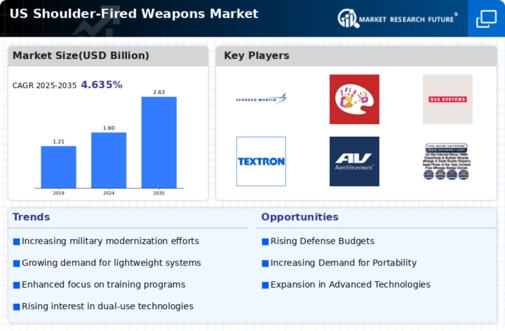Civilian Market Expansion
The shoulder fired-weapons market is experiencing expansion within the civilian sector, driven by growing interest in personal defense and recreational shooting. As more individuals seek effective self-defense solutions, the demand for shoulder fired weapons, including shotguns and carbines, is on the rise. In 2025, the civilian firearms market is projected to exceed $15 billion, with a notable portion attributed to shoulder fired systems. This trend suggests a shift in consumer preferences towards versatile and reliable weaponry for personal use. Additionally, the increasing popularity of shooting sports and hunting activities is likely to further stimulate market growth. As manufacturers respond to this demand by offering a wider range of products, the shoulder fired-weapons market is expected to benefit from the expanding civilian interest in firearms.
Increased Military Expenditure
The shoulder fired-weapons market is experiencing a notable surge due to increased military expenditure in the United States. The Department of Defense has allocated substantial budgets for modernization and procurement of advanced weaponry, which includes shoulder fired systems. In FY 2025, military spending is projected to reach approximately $800 billion, with a significant portion directed towards enhancing infantry capabilities. This trend indicates a growing recognition of the importance of portable and versatile weapon systems in modern warfare. As military operations evolve, the demand for lightweight, effective shoulder fired weapons is likely to rise, further driving market growth. The emphasis on improving soldier survivability and effectiveness on the battlefield is expected to sustain this upward trajectory in military investments, thereby positively impacting the shoulder fired-weapons market.
Rising Demand from Law Enforcement
The shoulder fired-weapons market is also witnessing a rising demand from law enforcement agencies across the United States. As urban crime rates fluctuate, police departments are increasingly seeking effective tools for crowd control and tactical operations. The market for non-lethal shoulder fired options, such as bean bag rounds and rubber bullets, is expanding as agencies prioritize public safety while maintaining operational effectiveness. In 2025, it is estimated that law enforcement agencies will allocate around $2 billion for the procurement of advanced weaponry, including shoulder fired systems. This trend suggests a shift towards equipping officers with versatile and adaptable weaponry, which could enhance their operational capabilities in various scenarios. Consequently, the growing focus on law enforcement modernization is likely to bolster the shoulder fired-weapons market.
Technological Integration and Innovation
Technological integration and innovation are pivotal drivers in the shoulder fired-weapons market. The advent of smart technologies, such as integrated targeting systems and enhanced optics, is transforming traditional shoulder fired weapons into more effective tools for military and law enforcement. The incorporation of advanced materials and manufacturing techniques is also contributing to the development of lighter and more durable systems. In 2025, the market for smart weaponry is projected to grow by approximately 15%, reflecting the increasing demand for high-tech solutions. This trend indicates that manufacturers are likely to invest in research and development to create next-generation shoulder fired systems that meet the evolving needs of users. As technology continues to advance, the shoulder fired-weapons market is expected to benefit from these innovations, enhancing overall market appeal.
Geopolitical Tensions and Defense Preparedness
Geopolitical tensions are a significant driver influencing the shoulder fired-weapons market. The current global landscape, characterized by rising conflicts and military posturing, has prompted the United States to enhance its defense preparedness. This environment has led to increased procurement of shoulder fired weapons, which are essential for rapid response and tactical operations. In 2025, defense analysts predict a 10% increase in demand for portable weapon systems as military strategies adapt to emerging threats. The focus on maintaining a robust defense posture is likely to sustain the growth of the shoulder fired-weapons market, as military forces prioritize equipping personnel with effective and versatile weaponry. This trend underscores the importance of adaptability in modern military operations, further driving market dynamics.























Leave a Comment